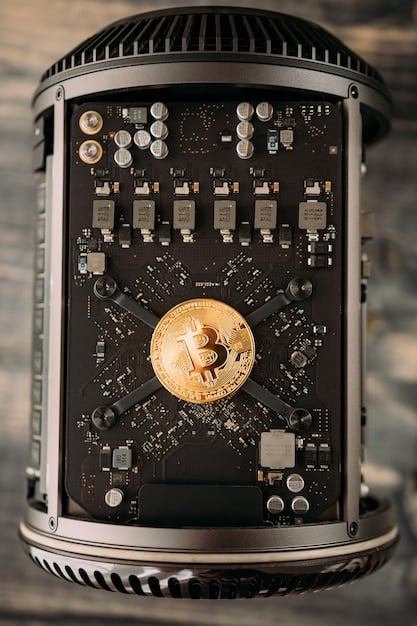Bitcoin and Environmental Concerns: Sustainable Mining Solutions in the US

Bitcoin mining’s environmental impact in the U.S. is driving the search for sustainable solutions, focusing on renewable energy sources, carbon offsetting, and technological innovations to mitigate ecological concerns.
The debate surrounding Bitcoin and Environmental Concerns: What Are the Solutions for Sustainable Bitcoin Mining in the US? has intensified as the digital currency gains wider acceptance. This article explores the key issues and highlights the innovative approaches being deployed across the United States to make Bitcoin mining more environmentally friendly.
Understanding Bitcoin’s Environmental Footprint
Bitcoin’s energy consumption has drawn attention due to its proof-of-work consensus mechanism. This section breaks down the key components of Bitcoin’s environmental impact.
The proof-of-work system, which is a core aspect of Bitcoin, requires significant computational power. Miners compete to solve complex cryptographic puzzles, the first to solve it validates the block and wins some Bitcoin.
Energy Consumption and Carbon Emissions
Bitcoin mining’s energy consumption mostly depends on fossil fuels, that can lead to carbon emissions. It has led to concerns about its impact on climate change. It is important to note the amount of energy used and the related carbon footprint.
- Energy Consumption Benchmarks: Bitcoin’s annual energy consumption often rivals that of small countries.
- Carbon Footprint: Depending on the energy source, Bitcoin mining can release many tons of carbon dioxide into the atmosphere.
- Geographic Variables: The environmental footprint varies depending on the location and source of energy used for mining.
The industry is exploring more energy-efficient mining hardware and protocols. Optimizing the efficiency of mining operations can greatly reduce the overall energy required.

Renewable Energy Integration in US Bitcoin Mining
Integrating renewable energy is considered a primary solution for sustainable Bitcoin mining. The US is seeing a rise in mining operations powered by clean energy.
Using renewable energy sources like solar, wind, and hydroelectric power, Bitcoin mining companies reduce their dependence on fossil fuels. This trend is critical to lowering the carbon footprint of mining operations in the US.
Solar and Wind Powered Mining Farms
Many new Bitcoin mining farms in the United States are focusing on solar and wind power. These initiatives aim to operate mining facilities with minimal environmental impact.
Solar and wind powered mining farms can often be tied to low price energy markets. This helps keep Bitcoin transaction fees steady and reliable.
- Texas Case: Texas is emerging as a major hub for Bitcoin mining, powered by wind and solar energy.
- Challenges of Renewable Energy: The intermittent nature of renewable energy requires reliable storage solutions.
- Government Incentives: The government provides credits and grants to encourage mining operations to use green power.
Several mining facilities have adopted battery storage solutions to maintain stable operations. These technologies will be important in supporting the mining industry’s transition to clean, sustainable and green sources.
Technological Innovations for Sustainable Mining
Technological advancements are essential in reducing the energy intensity of Bitcoin mining. Innovation leads to ways to optimize energy use and manage environmental impact.
New mining hardware and software enhance efficiency and energy savings. These innovations can play a significant role in making Bitcoin mining more sustainable in the long term.

Advanced Mining Hardware
The development of advanced ASIC (Application-Specific Integrated Circuit) miners has improved processing power while reducing energy consumption. Making use of these devices increases efficiency.
The latest generation of ASIC miners are much more energy-efficient than earlier models. Replacing old hardware is going to be important in reducing the industry’s carbon footprint.
- Immersion Cooling: Using liquid coolants to dissipate heat from mining hardware reduces energy use.
- Dynamic Frequency Scaling: This technology adjusts the operating frequency of mining hardware based on network conditions.
- Data Center Improvements: Optimizing data center infrastructure, including airflow and climate control, can save energy.
Software optimization is another area of importance, it can help reduce redundancy and increase efficiency. As technology gets better, we can expect to see even more advancements that optimize resource and energy usage.
Regulatory and Policy Frameworks in the US
Regulatory and policy frameworks play a significant role in the sustainability of Bitcoin mining in the US. Government regulations can incentivize sustainable practices.
Legislation that promotes the use of sustainable energy sources and imposes environmental standards can lead to cleaner Bitcoin mining practices. These policies can shape the way Bitcoin mining is approached, leading to greener outcomes.
Federal and State Policies
Both federal and state governments are working to establish policies that can affect the Bitcoin mining industry. These policies often involve environmental considerations and energy regulations.
Government assistance influences green mining projects. This encourages mining operations to accept environmentally friendly improvements.
- Energy Mandates: Some states have mandates for renewable energy that affect the way mining farms are operated.
- Tax Incentives: Tax incentives are available for mining facilities that use renewable energy sources.
- Environmental Standards: Environmental standards help reduce carbon emissions linked to mining operations.
Cooperation among government, industry, and environmental groups is also imperative to develop effective and practical policies. The US government may create a favorable regulatory environment to guarantee that Bitcoin mining matches environmental goals.
Carbon Offsetting and Green Initiatives
Carbon offsetting and green projects provide innovative processes for minimizing the environmental impact of Bitcoin mining. These projects help to offset carbon emissions and support ecological revitalization.
Mining companies are investing in carbon offsetting projects as a way to mitigate their environmental footprint. These initiatives demonstrate a commitment to environmental sustainability and responsibility.
Reforestation and Conservation Projects
Carbon offsetting can involve reforestation and conservation projects, which help to absorb carbon dioxide from the atmosphere. Supporting these initiatives can help reverse the ecological damage caused by mining operations.
Engaging in reforestation and conservation can significantly improve the environmental effects of Bitcoin mining. This can help mining farms become more environmentally conscious.
- Investing in Reforestation: Planting trees contributes to carbon sequestration and improves air quality.
- Supporting Conservation: Conservation projects protect wildlife habitats and preserve biodiversity.
- Purchasing Carbon Credits: Purchasing carbon credits helps fund environmental projects that offset carbon emissions.
Furthermore, investing in community-based environmental projects can also have widespread benefits. These initiatives help establish a balance between economic activities and ecological preservation.
The Future of Sustainable Bitcoin Mining in the US
Sustainable Bitcoin mining operations in the United States continue to evolve. The move towards green practices indicates a promising road.
Looking ahead, Bitcoin mining is likely to become greener as the industry embraces innovative technologies, sustainable practices, and supportive policies. This progress is necessary for Bitcoin to thrive without harming the environment.
Predictions and Trends
Several trends and forecasts suggest that sustainable Bitcoin mining will become more commonplace in the US. These developments point to a future where Bitcoin mining is both profitable and environmentally responsible.
Mining operations are attempting to reduce their environmental impact in order to promote sustainable growth and attract environmentally concerned investors.
- Increased Renewable Energy Use: Mining farms will rely increasingly on renewable energy sources.
- Technological Advances: Innovations in mining hardware and software will significantly reduce energy consumption.
- Policy Support: Government guidelines and tax credits will support green mining projects.
There are many steps involved in sustainable Bitcoin mining in the United States: innovation, regulation, and responsibility. By accepting these concepts, the Bitcoin mining sector can create a more sustainable future for the US and the rest of the globe.
| Key Point | Brief Description |
|---|---|
| ⚡ Renewable Energy | Integrating solar, wind, and hydro power into Bitcoin mining operations. |
| 💡 Tech Innovations | Using advanced ASIC miners and cooling technologies to reduce energy use. |
| 🌳 Carbon Offsetting | Investing in reforestation and conservation projects to balance carbon emissions. |
| 🏛️ Policy Support | Government incentives and energy mandates promoting sustainable mining practices. |
Frequently Asked Questions
▼
Bitcoin mining requires substantial energy due to its proof-of-work system, often relying on fossil fuels, leading to significant carbon emissions and environmental concerns.
▼
Renewable solutions include solar, wind, and hydroelectric power. Many US mining operations are now integrating these to reduce their environmental impact.
▼
Innovations include energy-efficient ASICs, immersion cooling, and dynamic frequency scaling. These lower energy consumption and improve overall efficiency.
▼
Policies such as tax incentives, energy mandates, and environmental standards spur the adoption of sustainable mining practices, helping to regulate and reduce the carbon footprint.
▼
Carbon offsetting involves investing in reforestation, conservation, and carbon credit projects to counterbalance the carbon emissions from Bitcoin mining activities.
Conclusion
Addressing Bitcoin and Environmental Concerns: What Are the Solutions for Sustainable Bitcoin Mining in the US? requires a multi-faceted approach. By integrating renewable energy, and encouraging policy support, the Bitcoin mining industry can move towards a greener, more sustainable future.





